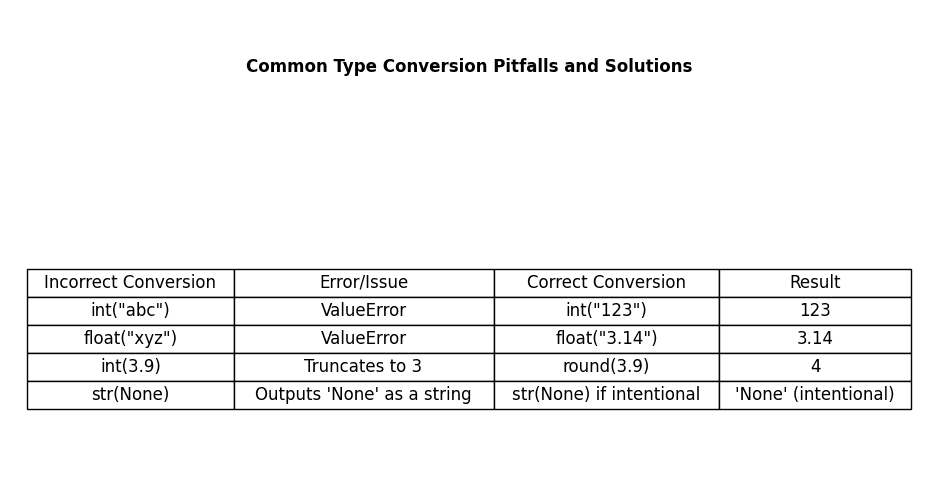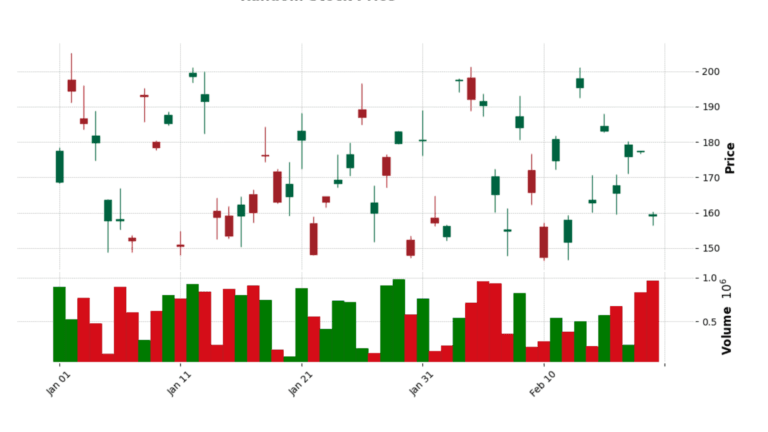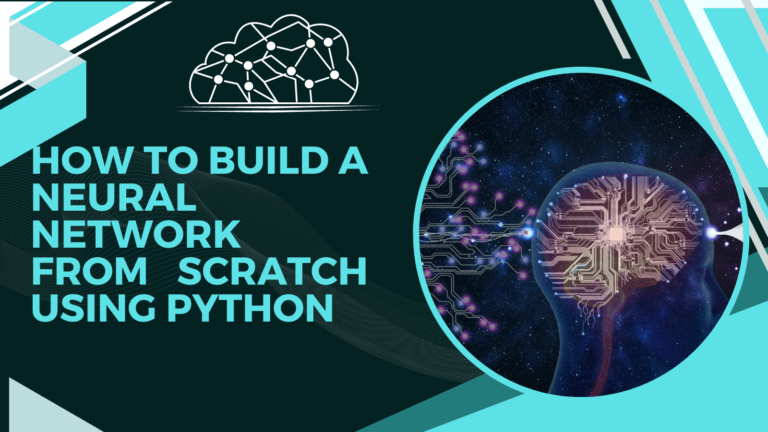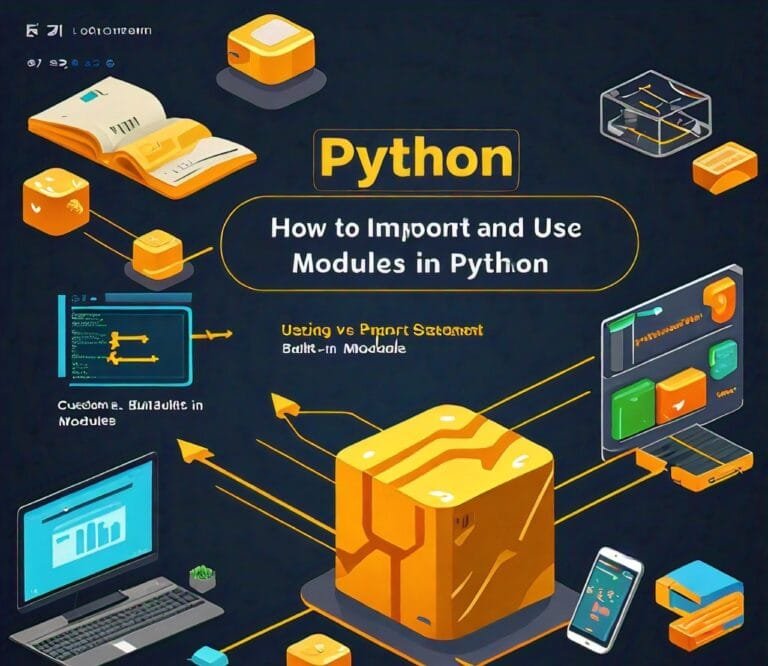Type Conversion in Python: The Ultimate Guide
Introduction
When writing Python programs, you often need to convert one data type into another. This is called type conversion. For example, you might have a number stored as a string, but you need it as an integer for calculations. Python makes type conversion easy with built-in functions.
In this guide, we’ll explore how to convert data types in Python with simple examples. You’ll learn:
- What type conversion is and why it’s important
- The difference between implicit and explicit type conversion
- How to use Python’s built-in functions for conversion
By the end of this guide, you’ll be able to convert data types confidently and avoid common mistakes. Let’s get started!
What is Type Conversion in Python?
Let’s say you have a number written as a string like this:
age = "25"
Right now, Python treats this as text, not a number. But what if you want to add 5 to it?
print(age + 5)
This will cause an error because Python cannot add a string to a number.
This is where type conversion comes in! Type conversion means changing a value from one data type to another. It helps Python handle data properly so you can do calculations, comparisons, and other operations without errors.
Two Types of Type Conversion
Python allows you to change data types in two ways:
Implicit Type Conversion (Type Promotion)
This is when Python automatically converts a smaller data type into a larger one without you doing anything. Python does this to avoid data loss.
For example:
num1 = 10 # Integer
num2 = 3.5 # Float
result = num1 + num2
print(result) # Output: 13.5
print(type(result)) # Output: <class 'float'>
What happened here?
num1is an integer (10)num2is a float (3.5)- Python automatically converts
num1into a float so that it matchesnum2 - The final result is a float (13.5)
This prevents unexpected rounding errors and ensures that operations are accurate.
Explicit Type Conversion (Type Casting)
Sometimes, you need to manually change a value’s type. This is called type casting. Python gives you built-in functions to do this:
int()→ Converts to integerfloat()→ Converts to floatstr()→ Converts to stringbool()→ Converts to boolean
Example: Converting a String to a Number
Let’s fix the error from earlier by converting "25" into an integer:
age = "25"
new_age = int(age) # Convert string to integer
print(new_age + 5) # Output: 30
Now Python understands that 25 is a number and allows you to add 5 to it!
Example: Converting a Number to a String
If you want to print a number with text, you need to convert it to a string:
score = 95
message = "Your score is " + str(score)
print(message) # Output: Your score is 95
Without str(score), Python would throw an error because you can’t mix numbers and text directly.
Why is Type Conversion Important?
- Prevents errors when working with different types of data
- Ensures calculations are accurate
- Helps with string formatting and user input handling
Now that you understand the basics, let’s explore Implicit Type Conversion in Detail.

Implicit Type Conversion in Python – How Python Handles It Automatically
When writing Python programs, you often work with different types of numbers like integers, floats, and complex numbers. But what happens when you try to mix them in a calculation?
Python automatically converts smaller data types into larger ones to prevent errors and data loss. This process is called implicit type conversion or type promotion.
Why Does Python Do This?
Python follows a hierarchy of data types:
- Integer (
int) – Whole numbers like5,10,100 - Float (
float) – Decimal numbers like3.14,2.5,0.99 - Complex (
complex) – Numbers with a real and imaginary part, like3 + 4j
When Python encounters an operation between different types, it automatically converts the smaller type into the larger type to avoid precision loss.
Example 1: Integer to Float Conversion
Let’s start with a simple case where we add an integer and a float:
num_int = 10 # Integer
num_float = 5.5 # Float
result = num_int + num_float # Integer automatically converts to float
print(result) # Output: 15.5
print(type(result)) # Output: <class 'float'>
What Happened Here?
num_intis an integer (10)num_floatis a float (5.5)- When we add them, Python automatically converts
num_intinto afloat(10.0) - The result is 15.5 (a float)
Why does Python convert int to float?
Because an integer is less precise than a float. If Python kept the result as an integer, we would lose the decimal part. To preserve accuracy, Python upgrades int to float.
Example 2: Float to Complex Conversion
What happens when we mix a float and a complex number? Let’s try:
num_float = 2.5 # Float
num_complex = 3 + 4j # Complex number
result = num_float + num_complex # Float automatically converts to complex
print(result) # Output: (5.5+4j)
print(type(result)) # Output: <class 'complex'>
What Happened Here?
num_floatis 2.5 (a float)num_complexis 3 + 4j (a complex number)- When we add them, Python converts
2.5into2.5 + 0j(a complex number) - The result is (5.5 + 4j) (a complex number)
Why does Python convert float to complex?
Because a complex number is the most powerful numerical type in Python. It can store both real and imaginary parts, while a float only stores real numbers.
What Python Doesn’t Convert Automatically
While Python is smart about type conversion, there are some things it won’t convert automatically.
Integer to String Conversion
num = 10
text = "Age: " + num # This will cause an error!
Python doesn’t convert numbers into strings automatically because adding a number to text is ambiguous. You must explicitly convert it using str():
text = "Age: " + str(num)
print(text) # Output: Age: 10
Complex to Float or Integer Conversion
Python never converts a complex number to a float or integer automatically because that would lose the imaginary part.
num_complex = 3 + 4j
num_float = float(num_complex) # This will cause an error!
If you want the real part, you need to extract it manually:
num_real = num_complex.real # Extract only the real part
print(num_real) # Output: 3.0
Key Takeaways
- Python automatically converts smaller types into larger ones to maintain accuracy
- Integer → Float → Complex (but not the other way around!)
- Python never converts complex numbers into other types automatically
- String and number operations require manual conversion
Python does a great job of handling conversions for you, but what if you want to force a conversion? That’s where explicit type conversion (type casting) comes in, which we’ll cover next!

Explicit Type Conversion in Python (Type Casting) – A Step-by-Step Guide
In Python, when you mix different data types, Python does some conversions automatically (implicit type conversion). But sometimes, you need to manually convert one type into another. This is called explicit type conversion or type casting.
What is Type Casting?
Type casting means forcing a value to change from one type to another using built-in functions. Python provides several functions to do this, and it’s important because:
- You may need to convert numbers to strings (e.g., for printing messages).
- We may receive user input as text but need it as a number.
- You may need to protect a list from being changed by converting it to a tuple.
Let’s go step by step and explore different conversions!
Must Read
- History of AI
- Interactive Introduction to AI: Machine Learning, Neural Networks & Supervised Learning for Beginners
- Python String Comparison Tutorial: Complete Guide
- How to Build a Python Port Scanner From Scratch
- Complete Beginner’s Guide to Hashing and Cryptography in Python
Python’s Type Casting Functions
Python provides several built-in functions to convert data types:
| Function | Converts To | Example |
|---|---|---|
int(x) | Integer | int("42") → 42 |
float(x) | Float | float("3.14") → 3.14 |
str(x) | String | str(100) → "100" |
list(x) | List | list((1, 2, 3)) → [1, 2, 3] |
tuple(x) | Tuple | tuple([1, 2, 3]) → (1, 2, 3) |
Now, let’s explore each one with detailed examples!
Converting an Integer to a String
Why do we need this?
Imagine you want to print a message like:
age = 25
print("Your age is: " + age) # ❌ This will cause an error!
Error: Python doesn’t allow adding numbers (int) and text (str) together!
Solution: Use str() to Convert the Integer to a String
age = 25
age_str = str(age) # Convert integer to string
print("Your age is: " + age_str) # ✅ No error!
Output:
Your age is: 25
Now it works! Because we manually converted age into a string using str().
Converting a String to an Integer
Why do we need this?
If you ask a user to enter a number, Python treats input as a string:
num = input("Enter a number: ") # User enters: 10
print(num * 2) # ❌ This repeats the string: "1010"
Solution: Convert it to an Integer Using int()
num = input("Enter a number: ") # User enters: 10
num_int = int(num) # Convert string to integer
print(num_int * 2) # ✅ Correct multiplication: 20
Output:
Enter a number: 10
20
Without int(), Python treats "10" as text and repeats it. Using int(), we convert it to a number for calculations.
⚠️ Be careful! If you try to convert "abc" to an integer, you’ll get an error!
Converting a String to a Float
Why do we need this?
If the user enters a decimal number (like "3.14"), we need it as a float for calculations.
num_str = "3.14"
num_float = float(num_str) # Convert to float
print(num_float * 2) # ✅ Works correctly: 6.28
Output:
6.28
Remember:
- Use
int()for whole numbers ("10" → 10). - Use
float()for decimal numbers ("3.14" → 3.14).
Converting a List to a Tuple
Why do we need this?
A list can be changed (mutable), but a tuple cannot (immutable). If you want to protect data from changes, convert a list to a tuple.
my_list = [1, 2, 3]
my_tuple = tuple(my_list) # Convert list to tuple
print(my_tuple, type(my_tuple))
Output:
(1, 2, 3) <class 'tuple'>
Now, if someone tries to modify my_tuple, Python will give an error!
my_tuple[0] = 10 # ❌ Error: Tuples cannot be changed!
Converting a Tuple to a List
Why do we need this?
Tuples cannot be modified, but lists can. If you need to edit a tuple, first convert it into a list.
my_tuple = (10, 20, 30)
my_list = list(my_tuple) # Convert tuple to list
my_list.append(40) # Now we can add a new item!
print(my_list)
Output:
[10, 20, 30, 40]
Now we can add elements because we changed the tuple into a list.
Converting a Number to a Boolean
Why do we need this?
Python treats 0 as False and any other number as True.
print(bool(0)) # Output: False
print(bool(1)) # Output: True
print(bool(100)) # Output: True
What Happens When You Convert Wrong Data?
Python is strict about conversions. If you try to convert incompatible types, you’ll get errors.
Wrong:
num = "Hello"
print(int(num)) # ❌ Error! You can't convert text into a number!
Fix: Only convert strings that contain numbers ("123", "99").
Summary – When to Use Type Casting?
- Use
str()when working with text and numbers together - Use
int()orfloat()when performing calculations with user input - You have to use
tuple()when you don’t want a list to be modified - Use
list()when you want to modify a tuple
Python doesn’t convert everything automatically, but with explicit type conversion, you have full control!
Common Pitfalls in Type Conversion
Type conversion in Python is powerful, but it can cause errors or unexpected results if not handled properly. Let’s go through some common mistakes and how to avoid them.

Handling TypeErrors in Python
Why does string-to-integer conversion fail?
Python allows you to convert a string to an integer only if it contains digits. But if the string has letters or special characters, Python raises a ValueError.
Incorrect:
num_str = "123abc"
num_int = int(num_str) # ❌ ValueError: invalid literal for int()
How to Fix It?
✔ Check if the string contains only numbers before conversion using .isdigit():
num_str = "123abc"
if num_str.isdigit():
num_int = int(num_str) # Converts only if it's a valid number
print(num_int)
else:
print("Cannot convert: The string contains non-numeric characters")
Output:
Cannot convert: The string contains non-numeric characters
Use try-except to handle errors gracefully:
num_str = "123abc"
try:
num_int = int(num_str)
print(num_int)
except ValueError:
print("Conversion failed! The string is not a valid number.")
Output:
Conversion failed! The string is not a valid number.
Key Takeaway: Before converting a string to an integer, always check if it contains only digits!
Avoiding Data Loss in Type Conversion
Why does converting float to int lose data?
When you convert a floating-point number (float) to an integer (int), Python removes (truncates) the decimal part.
num_float = 9.8
num_int = int(num_float) # Converts to 9, losing .8
print(num_int)
Output:
9
Key Point: The int() function does NOT round; it truncates the decimal part.
How to Fix It?
✔ Use round() to get the nearest whole number:
num_float = 9.8
num_rounded = round(num_float)
print(num_rounded) # Output: 10
Use math.ceil() or math.floor() for more control:
import math
num_float = 9.8
print(math.ceil(num_float)) # ✅ Output: 10 (Rounds UP)
print(math.floor(num_float)) # ✅ Output: 9 (Rounds DOWN)
Key Takeaway: If you need rounding, use round(), math.ceil(), or math.floor() instead of int().
Mixing Data Types in Arithmetic Operations
Python automatically converts integers to floats in arithmetic operations to prevent data loss. However, be cautious when mixing types.
Unexpected Output Example:
result = 5 + "10" # ❌ TypeError: unsupported operand types
How to Fix It?
✔ Manually convert "10" to an integer before addition:
result = 5 + int("10")
print(result) # ✅ Output: 15
✔ Or convert everything to a string if you want concatenation:
result = str(5) + "10"
print(result) # ✅ Output: "510"
Key Takeaway: When mixing numbers and strings, always convert them to the appropriate type before performing operations.
Summary – How to Avoid Type Conversion Errors?
❌ Don’t: Convert strings with letters to integers ("123abc" → int() error).
✔ Do: Check .isdigit() before conversion.
❌ Don’t: Assume int() rounds numbers (9.8 → 9, NOT 10).
✔ Do: Use round(), math.ceil(), or math.floor().
❌ Don’t: Mix numbers and strings in operations (5 + "10").
✔ Do: Convert data before using it (int("10") or str(5)).
By handling type conversion carefully, you can avoid unexpected errors and data loss!
Best Practices for Type Conversion in Python
To avoid errors and ensure smooth execution, follow these best practices when converting data types in Python.
1. Use the Right Conversion Method for Each Data Type
Different types of data require different conversion methods. Using the wrong method can lead to unexpected results or errors.
✔ Choosing the Right Function
| Data Type | Convert To | Use This Function |
|---|---|---|
| Integer → String | "100" | str() |
| String → Integer | 100 | int() (only if the string is numeric) |
| String → Float | 10.5 | float() |
| Integer → Float | 10.0 | float() |
| List → Tuple | (1, 2, 3) | tuple() |
| Tuple → List | [1, 2, 3] | list() |
Example: Converting a Tuple to a List
my_tuple = (1, 2, 3)
my_list = list(my_tuple) # ✅ Correct method
print(my_list, type(my_list)) # Output: [1, 2, 3] <class 'list'>
Key Takeaway: Use the correct conversion function for each type.
2. Handle Exceptions to Prevent Runtime Errors
Some conversions can fail if the data isn’t in the right format. Instead of crashing the program, handle errors using try-except.
✔ Example: Handling String to Integer Conversion Errors
num_str = "123abc" # Contains non-numeric characters
try:
num_int = int(num_str) # ❌ This will cause an error
print(num_int)
except ValueError:
print("Conversion failed! The string must contain only numbers.")
Output:
Conversion failed! The string must contain only numbers.
Key Takeaway: Always use try-except when converting user input or uncertain data types.
3. Verify Conversions Using type() Before Using Values
Before performing operations on converted values, check if the conversion was successful using the type() function.
✔ Example: Checking Data Type Before Use
num_str = "200"
# Convert string to integer
num_int = int(num_str)
# Verify the conversion
if isinstance(num_int, int):
print("Conversion successful:", num_int, type(num_int))
else:
print("Conversion failed!")
Output:
Conversion successful: 200 <class 'int'>
Key Takeaway: Use type() or isinstance() to confirm the data type before using the converted value.
4. Be Careful with Floating-Point to Integer Conversion
When converting float to int, Python truncates (removes the decimal part) instead of rounding.
✔ Example: Truncation vs. Rounding
num_float = 9.8
# Truncates the decimal part
num_int = int(num_float)
print(num_int) # Output: 9
# Rounds to the nearest whole number
num_rounded = round(num_float)
print(num_rounded) # Output: 10
Key Takeaway: Use round() instead of int() if you want to round the number.
5. Convert User Input Before Using It
Python treats all user input as a string by default. You must convert it before performing calculations.
✔ Example: Converting User Input Correctly
user_input = input("Enter a number: ") # Always returns a string
# Convert input to integer
if user_input.isdigit():
user_number = int(user_input)
print("You entered:", user_number, type(user_number))
else:
print("Invalid input! Please enter a numeric value.")
Key Takeaway: Always convert user input before performing calculations.
6. Avoid Mixing Data Types in Arithmetic Operations
Python automatically promotes integers to floats in mixed operations, but mixing numbers and strings causes errors.
❌ Incorrect:
result = 10 + "5" # ❌ TypeError
✔ Correct:
result = 10 + int("5") # ✅ Convert string to int before addition
print(result) # Output: 15
Key Takeaway: Convert data types before performing operations to avoid errors.
7. Be Aware of Boolean Conversions
In Python, booleans (True and False) behave like numbers:
Trueconverts to1Falseconverts to0
✔ Example: Boolean to Integer Conversion
print(int(True)) # Output: 1
print(int(False)) # Output: 0
However, converting numbers to boolean follows this rule:
0converts toFalse- Any nonzero number converts to
True
print(bool(0)) # Output: False
print(bool(10)) # Output: True
Key Takeaway: Python treats 0 as False and nonzero values as True when converting numbers to booleans.
Summary – Key Best Practices for Type Conversion
- Use the right conversion function (
int(),str(),float(), etc.). - Handle exceptions (
try-except) when converting uncertain data. - Check the type with
type()orisinstance()before using converted values. - Use
round()instead ofint()to avoid data loss. - Convert user input before using it (
int(input())). - Avoid mixing incompatible data types (
int+"str"). - Understand boolean conversions (
True → 1,False → 0).
By following these best practices, you can avoid common errors and write cleaner, safer Python code!
Conclusion
Type conversion is a fundamental concept in Python that helps ensure your program works with the right data types. Whether Python is automatically handling conversions (implicit type conversion) or you manually convert data types (explicit type conversion), understanding these processes is essential for writing error-free, efficient code.
Key Takeaways:
- Implicit type conversion happens automatically when Python upgrades smaller data types to larger ones.
- Explicit type conversion requires you to use functions like
int(),float(),str(),list(), andtuple(). - Common pitfalls include losing data when converting floats to integers and encountering
ValueErrorwhen converting non-numeric strings to integers. - Best practices include using the right conversion functions, handling exceptions with
try-except, and verifying conversions before using them.
By mastering type conversion, you can prevent errors, write cleaner code, and handle user input effectively. Keep experimenting with different data types, and soon, type conversion will feel like second nature!
FAQs
🔹 Implicit type conversion happens automatically when Python upgrades smaller data types (e.g., int to float) without losing data.
🔹 Explicit type conversion (type casting) requires using functions like int(), float(), or str() to manually convert data types.
When you use int() to convert a float, Python truncates the decimal part instead of rounding.
Example:
num_float = 9.8
num_int = int(num_float)
print(num_int) # Output: 9
To round the number instead, use round().
If a string contains non-numeric characters, converting it to an integer will raise a ValueError.
Example of an error:
num_str = “123abc”
num_int = int(num_str) # This will cause an error!
To prevent this, always validate input before conversion.
Yes! You can use list() to convert a tuple into a list.
Example:
my_tuple = (1, 2, 3)
my_list = list(my_tuple)
print(my_list) # Output: [1, 2, 3]
This is useful when you need a modifiable version of a tuple.
External Resources
To deepen your understanding of type conversion in Python, check out these valuable resources:
📖 Official Documentation
🔹 Python Data Types and Type Conversion – Python Docs
🔹 Built-in Functions for Type Conversion – Python Docs








Leave a Reply